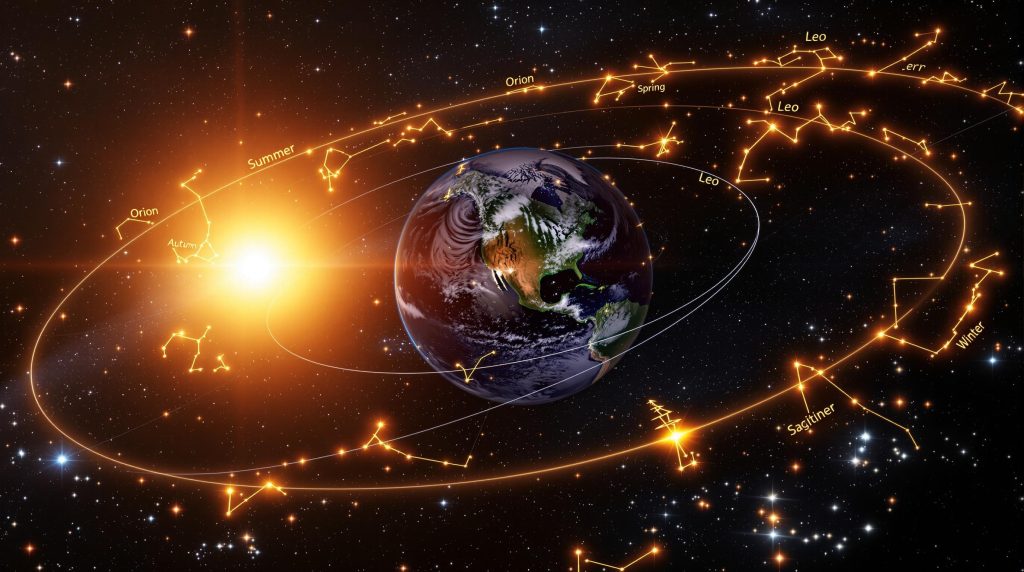Have you ever looked up at the night sky in summer and noticed different Seasonal Constellations compared to what you see in winter? This celestial shift is not just a random occurrence—it’s a fascinating result of Earth’s movement through space. Understanding why we see different constellations in different seasons offers a glimpse into the dynamics of our planet’s orbit and its position in the universe.
The Role of Earth’s Orbit (Seasonal Constellations)
The primary reason for the seasonal change in visible constellations lies in Earth’s orbit around the Sun.
- Earth’s Position Changes Throughout the Year:
- As Earth orbits the Sun, the night side (the side facing away from the Sun) points in different directions relative to the stars.
- This shift alters which parts of the night sky are visible from our perspective.
- The Ecliptic Path:
- Earth’s orbit follows a path called the ecliptic, which is the plane of our solar system.
- Constellations along this path, known as the zodiac constellations, appear in predictable patterns during specific months.

Key Examples of Seasonal Constellations
Certain constellations are associated with specific seasons, making them easier to spot at particular times of the year.
- Winter Constellations:
- Orion the Hunter: One of the most recognizable constellations, Orion dominates winter skies with its bright stars Betelgeuse and Rigel.
- Canis Major and Sirius: Known for Sirius, the brightest star in the night sky, Canis Major is a winter favorite.
- Summer Constellations:
- Cygnus the Swan: With the Milky Way as a backdrop, Cygnus is a highlight of summer evenings.
- Lyra and Vega: Vega, part of the Summer Triangle, shines brightly in warm months.
- Spring and Fall Constellations:
- Leo the Lion in spring and Pegasus in fall are examples of transitional constellations that mark the changing seasons.
The Role of Earth’s Axial Tilt
Earth’s axial tilt also plays a crucial role in the visibility of constellations:
- The tilt affects the angle at which the night sky appears relative to the horizon.
- This results in some constellations being prominent in one hemisphere while nearly invisible in the other.
For example, Southern Hemisphere stargazers enjoy unique views of constellations like the Southern Cross, which cannot be seen from the Northern Hemisphere.
Earth’s axial tilt, or obliquity, plays a fundamental role in how we perceive the night sky and the constellations that are visible at different times of the year. The tilt affects how sunlight and starlight interact with our planet, and it is pivotal in shaping the seasonal changes in the sky. Let’s dive deeper into this intriguing phenomenon.
- What is Axial Tilt?
- Earth’s axis is tilted at an angle of approximately 23.5 degrees relative to its orbital plane around the Sun.
- This tilt creates varying angles of sunlight throughout the year, leading to the seasons.
- Impact on Seasonal Constellations:
- As Earth revolves around the Sun, the night sky changes because the tilt determines which constellations appear overhead.
- In summer, certain constellations dominate due to Earth’s orientation, while others are prominent in winter.
- Hemispheric Differences:
- The axial tilt means that different constellations are visible in the Northern Hemisphere and the Southern Hemisphere during the same season.
- For example, Orion is a winter constellation in the Northern Hemisphere but is seen in summer in the Southern Hemisphere.
- Circumpolar Constellations:
- Some constellations, like Ursa Major in the north and Crux in the south, are visible year-round because they are near the celestial poles.
- Their visibility is a direct result of Earth’s axial tilt, which keeps them above the horizon.
- Changing Sky Throughout the Night:
- The axial tilt also affects the rotation of the sky. As Earth spins on its tilted axis, stars rise and set at angles that differ depending on your latitude.
- The Zodiac’s Connection to Tilt:
- The constellations of the zodiac align with Earth’s orbit around the Sun.
- The tilt ensures that different zodiac constellations are visible in specific months, marking the Sun’s apparent path (ecliptic) through the sky.
- Ecliptic and Equator Intersection:
- The celestial equator (Earth’s equatorial plane projected into space) intersects the ecliptic plane at an angle of 23.5 degrees, defining the solstices and equinoxes.
- Sky Visibility Varies by Latitude:
- In the polar regions, the axial tilt means prolonged visibility of certain stars during the long nights of winter.
- Near the equator, more constellations are visible year-round due to Earth’s rotational dynamics.
- Historical Implications:
- Ancient cultures used the tilt and corresponding celestial changes to build calendars and predict agricultural cycles.
- For instance, the rise of specific stars heralded seasonal changes.
- Future Implications:
- Earth’s axial tilt is not fixed; it slowly oscillates over a 41,000-year cycle, affecting long-term climate patterns and star visibility.
Earth’s axial tilt is not just responsible for seasons but also shapes our view of the universe. It determines which stars and constellations dominate the night sky at any given time, offering a dynamic and ever-changing celestial display. Understanding this interplay enhances our appreciation of the interconnectedness between our planet and the cosmos.

The Annual Celestial Cycle
Astronomers divide the celestial sphere into 88 official constellations, but not all are visible year-round. This annual cycle depends on three factors:
- Earth’s Orbital Period: It takes roughly 365 days for Earth to complete one orbit around the Sun.
- Diurnal Motion: As Earth rotates, constellations rise and set, changing their positions nightly.
- Circumpolar Constellations: Some constellations near the poles, such as Ursa Major in the north, are visible all year due to their proximity to the celestial poles.
How to Track Seasonal Constellations
Thanks to modern tools, tracking seasonal constellations has never been easier:
- Stargazing Apps: Apps like Star Walk and Night Sky use augmented reality to map constellations in real-time.
- Planetarium Shows: Visiting a local planetarium can provide guided tours of seasonal skies.
- Star Charts: Old-school star maps still serve as excellent guides for identifying constellations based on the time of year.
Why Understanding Seasonal Constellations Matters
Recognizing seasonal constellations isn’t just a fun hobby—it connects us to ancient traditions and modern science:
- Cultural Significance: For millennia, constellations have guided navigation, agriculture, and storytelling across cultures.
- Astronomical Insights: Seasonal changes in the night sky reflect Earth’s orbit, offering a deeper understanding of our place in the cosmos.
- Enjoying Nature’s Rhythm: Stargazing allows us to reconnect with nature and observe the patterns of the universe.
Conclusion
The beauty of the night sky is ever-changing, and the seasonal shift in constellations is a direct result of Earth’s journey through space. By understanding why we see different constellations in different seasons, we can appreciate the intricate dance of our planet in the vast cosmos.
Explore the night sky, track your favorite constellations, and stay curious about the universe with SpaceyV!



